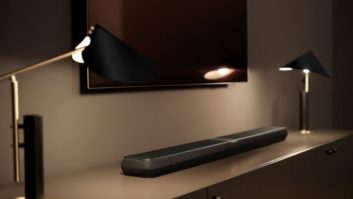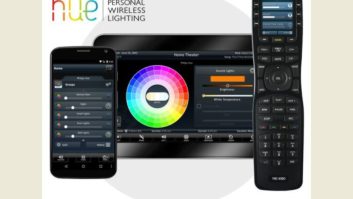In the first major hardware upgrade to its wireless multiroom music system, Sonos doubled the range of its wireless mesh-network technology to deliver a high-quality signal to more places more easily within a house.
To enhance in-home transmission, Sonos replaced its proprietary mesh-network enhancement to the wireless IEEE 802.11g standard with a mesh-network version of the draft IEEE 802.11n wireless standard.
The company also reduced the size of its amplified client, boosted the client’s power output, launched other new software upgrades and outlined plans to support the launch. Those plans include a revised Web site, new point-of-sale (POS) displays and a more aggressive plan to help dealers connect displayed Sonos systems to the Internet to stream music directly from Internet radio stations and music services.
The upgraded hardware goes on sale Aug. 5 at the same price as the previous products.
Sonos’ system distributes music wirelessly from a networked PC or network-attached storage (NAS) device to clients, or Zone Players, placed in other rooms. One type of Zone incorporates an amplifier and connects to any pair of speakers. Another type of Zone Player lacks amplifier but connects to any existing home stereo system. The clients also stream music from Internet radio stations and music services directly through a broadband modem without the use of a PC. At least one client, or a $99 ZoneBridge repeater, must be hardwired to a network router’s Ethernet port.
To control the system, consumers us a handheld wireless-RF LCD remote that displays a PC’s song library and menu of Web-based streaming sites. The controller, which uses n-compatible 802.11g wireless technology, also directs different songs to different clients, allowing consumers to stream up to 16 different songs simultaneously to up to 32 different zones from a single PC or NAS and from Internet radio stations and music services. Consumers who connect additional PCs, NAS devices and legacy analog sources can play up to 32 different songs in 32 different rooms, Sonos said.
For $999, consumers can buy a bundle consisting of the current-generation controller, the new ZP120 amplified client, and the new ZP90 un-amplified client. When purchased separately, the controller continues to retail for a suggested $349, and the new amplified and un-amplified clients retail for $499 and $349, respectively.
In the two new Zone Players, Sonos combines its proprietary mesh-network version of IEEE 802.11n with three-antenna multiple-input multiple-output (MIMO) technology to double wireless range, thus reducing the potential number of dead spots within a home. The updated technology also improves resistance to multipath interference, which is caused by reflective materials such as brick walls and chain-link fences and reduces the range of listenable signals, the company said.
Although the range of a Sonos system “is almost endless” because it uses mesh-network technology to turn every client into a repeater, Sonos chose to adopt 802.11n’s physical layer to reduce the potential for dead zones within a home, said president Phil Abram. That will simplify the placement of clients within a home by consumers, he explained. In some homes, especially larger homes or those with lots of brick walls, consumers might not need to buy one or more dedicated $99 Zone Bridge repeaters to fill in coverage gaps. “This gives the customer more assurance that they don’t have to worry about the wireless network,” Abram said.
In the past, the company said the range of its ZonePlayers ranged from 50 feet to 150 feet, depending on the house.
Although the current Zone Bridge and controller use n-compatible 802.11g, the company said additional n-equipped products would make sense in the future. Sonos, however, didn’t say if an n-equipped ZoneBridge or controller is in development.
The ranges of the current ZoneBridge and controller would remain at 802.11g levels when communicating with the new n-based hardware, Sonos said.
In another hardware upgrade, the company reduced the size of its new amplified client by more than 40 percent to 3.5- by 7.3- by 8.15 inches while boosting amplifier output by 10 percent to 2×55 watts with less than 0.02 percent THD into 8 ohms. The un-amplified ZonePlayer 90 is the same size as its predecessor.
Among software upgrades, the company expanded the number of songs that can be streamed from a PC’s music library to 65,000 from 50,000, and it added support for new brands and models of NAS devices.
Also as part of the new software upgrade, Sonos is offering more than $200 worth of free music downloads to all new and existing Sonos customers who register their system.
Sonos launched its first system in 2005 and over the years upgraded its software eight times to, among other things, improve the user interface, expand the number of accessible Internet streaming sites to about 600, allow for streaming of protected WMA files from a PC, and enable direct support of subscription-based music services.
Also to promote the new products, the company revamped its Web site to “show how your lifestyle will be more enjoyable” with a Sonos system, Abram said. “The current site is product-focused and not lifestyle enough.”
To support retailers, Sonos is rolling out new POS fixtures that will start appearing in stores this month to “let consumers see all elements of a bundle” and to “explain multiroom music better,” Abram said. Current POS displays usually display only the controller, “but the other components were not presented so that consumers could associate them with one another,” he explained.
Just as important, Sonos plans to more aggressively help dealers’ IT departments connect the displays to the store’s computer network to stream live music from the Internet, he added. Sonos experts can help retailers overcome firewall issues and other challenges involved in connecting Sonos systems to store networks designed for point-of-sale applications, he said. Some dealers have connected music-laden NAS drives to displayed Sonos systems, but the drives contains only select songs that might not appeal to all customers, he noted. With a live Internet connection, the displayed system will be “more like what will be in the home,” Abram added, noting that 97 percent of Sonos customers are broadband-connected.








